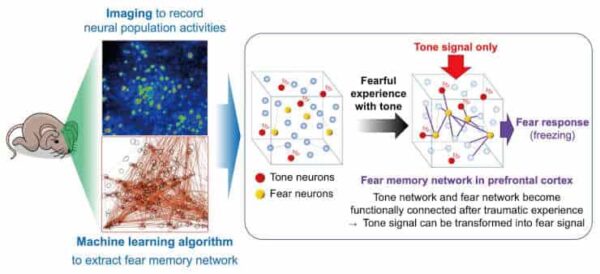Scientists have long wondered about the physical changes in the brain that occur when a new memory is formed. The National Institute for Physiological Sciences (NIPS) has now thrown light on this enthralling neurological conundrum.
The research team was successful in detecting the brain neuronal networks involved in trauma memory by combining optical and machine-learning-based approaches, capturing the complex changes that occur during memory formation and uncovering the mechanisms by which trauma memories are created.
Using regression methods and graphical modelling, they found that fear conditioning mediated dorso-medial prefrontal cortex reorganization to bring about conditioned responses characterized by enhanced internal coactivity, functional connectivity, and association with conditioned stimuli.
Associative Memories

Animals must learn to adapt to changing conditions in order to survive. Associative learning, which includes classical conditioning, is one of the most basic types of learning and has received a lot of attention in the last century.
Technological advances in molecular, genetic, and optogenetic technologies have enabled the identification of brain areas and specific populations of neurons that control the construction and retrieval of new associative memories over the previous two decades.
For instance, the dorsal part of the medial prefrontal cortex (dmPFC) is critical for the retrieval of associative fear memory in rodents. However, the manner in which the neurons in this region encode and retrieve associative memory is not well understood. This was the area that the research team sought to clarify.
“The dmPFC shows specific neural activation and synchrony during fear-memory retrieval and evoked fear responses, such as freezing and heart rate deceleration,”
explained lead author Masakazu Agetsuma.
Longitudinal Two-photon Imaging
The dmPFC in mice was silenced artificially, which inhibited fear responses, demonstrating that this region is essential to recall associative fear memory. The researchers intended to investigate how changes in the dorsal medial prefrontal cortex specifically govern new associative memory information because it is linked to brain systems important in learning and associated psychiatric illnesses.
The research team utilized longitudinal two-photon imaging and a variety of computational neuroscience techniques to determine how neural activity in the mouse prefrontal cortex changes following fear conditioning learning. Prefrontal neurons behave in a highly complex manner, and each neuron responds to various sensory and motor events.
To solve this complication, the researchers devised a new analytical method based on the “elastic net,” a machine-learning algorithm, to determine which neurons encode fear memories. They then used graphical modelling to examine the spatial layout and functional connections of the neurons.
“We successfully detected a neural population that encodes fear memory. Our analyses showed us that fear conditioning induced the formation of a fear-memory neural network with ‘hub’ neurons that functionally connected the memory neurons,
said Agetsuma.
Novel Associative Connection
Importantly, the researchers discovered direct evidence that associative memory formation was accompanied by a novel associative connection between two previously distinct networks, namely the conditioned stimulus (CS) network and the unconditioned stimulus (US) network.
“We propose that this newly discovered connection might facilitate information processing by triggering a fear response (CR) to a CS (i.e., a neural network for CS-to-CR transformation),”
the authors write.
Memories have long been assumed to be produced through the strengthening of brain connections, which are strengthened by the repetitive firing of groups of neurons. The current study’s findings, which are based on both real-life observations and model-based research, support this.
Furthermore, the study demonstrates how combined methods (optics and machine learning) can be used to visualize the dynamics of neural networks in great detail. These techniques could be used to uncover additional information about the neurological changes associated with learning and memory.
Abstract
Associative learning is crucial for adapting to environmental changes. Interactions among neuronal populations involving the dorso-medial prefrontal cortex (dmPFC) are proposed to regulate associative learning, but how these neuronal populations store and process information about the association remains unclear. Here we developed a pipeline for longitudinal two-photon imaging and computational dissection of neural population activities in male mouse dmPFC during fear-conditioning procedures, enabling us to detect learning-dependent changes in the dmPFC network topology. Using regularized regression methods and graphical modeling, we found that fear conditioning drove dmPFC reorganization to generate a neuronal ensemble encoding conditioned responses (CR) characterized by enhanced internal coactivity, functional connectivity, and association with conditioned stimuli (CS). Importantly, neurons strongly responding to unconditioned stimuli during conditioning subsequently became hubs of this novel associative network for the CS-to-CR transformation. Altogether, we demonstrate learning-dependent dynamic modulation of population coding structured on the activity-dependent formation of the hub network within the dmPFC.
Reference:
- Agetsuma, M., Sato, I., Tanaka, Y.R. et al. Activity-dependent organization of prefrontal hub-networks for associative learning and signal transformation. Nat Commun 14, 5996 (2023). doi: 10.1038/s41467-023-41547-5
